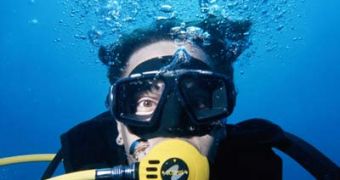A typical Self-Contained Underwater Breathing Apparatus, or scuba gear for short, usually consists of a tank containing compressed air and a mouthpiece used to regulate the flow of air from the tank into the lungs. But breathing air in this manner is extremely inefficient, especially while considering the applications of this particular apparatus. This is because the air you breathe out still contains a fair amount of oxygen.
Modern scuba gear use rebreathers to filter out the exhaled carbon dioxide gas and gather the oxygen, to recirculate it until it is consumed. By doing so, the underwater breathing process becomes more efficient, allowing professional divers to remain submerged for a longer time.
Basically, a rebreather has three roles. One is to remove the carbon dioxide gas from the exhaled air. This is done by pumping it through a chamber containing sodium hydroxide, which reacts with the carbon dioxide and forms calcium carbonate. Secondly, the rebreather must complement the amount of consumed oxygen with fresh one from the tank. The oxygen tanks may contain either pure oxygen or oxygen mixed with either nitrogen or helium.
Alternatively, the rebreather must control the oxygen concentration inside the breathing loop after the exhaled oxygen is combined with fresh oxygen, for an optimal oxygen delivery sequence.
Types of rebreathers
Currently, there are three types of rebreather systems commercially available - oxygen rebreathers, semi-closed circuit and closed circuit ones. The oxygen rebreathers make use of pure oxygen tanks as the only source of breathing gas. They are generally disadvantaged by the facts that they cannot be used in decompression depths and may pose oxygen intoxication risks.
Semi-closed circuit rebreathers on the other hand, carry tanks containing oxygen mixed with another gas - nitrogen, helium - and enable divers to surpass decompression depths without any risk of suffering from oxygen intoxication. Closed-circuit rebreathers are a combination between the two, using both pure oxygen and oxygen mixed with various gases.
Besides being highly efficient in making use of the gas carried by a diver, rebreathers are also lighter than any other conventional scuba gear. The normal concentration of oxygen inside the atmospheric air is about 21 percent, while that of nitrogen is 78 percent. Since nitrogen is not as critical as oxygen, almost three quarters of the gas carried in conventional scuba tanks is dead weight. Also, less nitrogen is circulated through the system with the help of rebreathers, thus the effects of decompression are reduced to minimum.
Because they recycle oxygen and carbon dioxide is filtered through sodium hydroxide, very little or no gas is ever pumped into the water to produce the characteristic bubbles.

 14 DAY TRIAL //
14 DAY TRIAL //